William Tecumseh Sherman
William Tecumseh Sherman (/tɪˈkʌmsə/ tih-KUM-sə;[4][5] February 8, 1820 – February 14, 1891) was an American soldier, businessman, educator, and author. He served as a general in the Union Army during the American Civil War (1861–1865), achieving recognition for his command of military strategy as well as criticism for the harshness of the scorched-earth policies that he implemented against the Confederate States.[6] British military theorist and historian B. H. Liddell Hart declared that Sherman was "the first modern general".[7][8]
William Tecumseh Sherman | |
|---|---|
_(cropped).jpg.webp) Photograph by Mathew Brady of Sherman at Washington, D.C., in May 1865. The black ribbon of mourning on his left arm is for President Abraham Lincoln.[1] | |
| Commanding General of the U.S. Army | |
| In office March 4, 1869 – November 1, 1883 | |
| President | |
| Preceded by | Ulysses S. Grant |
| Succeeded by | Philip Sheridan |
| Acting United States Secretary of War | |
| In office September 6, 1869 – October 25, 1869 | |
| President | Ulysses S. Grant |
| Preceded by | John Aaron Rawlins |
| Succeeded by | William W. Belknap |
| Personal details | |
| Born | February 8, 1820 Lancaster, Ohio, U.S. |
| Died | February 14, 1891 (aged 71) New York City, U.S. |
| Resting place | Calvary Cemetery, St. Louis, Missouri, U.S. |
| Political party | Republican |
| Spouse | Eleanor Boyle Ewing
(m. 1850; died 1888) |
| Education | United States Military Academy (BS) |
| Signature | |
| Nicknames |
|
| Military service | |
| Branch/service | |
| Years of service |
|
| Rank |
|
| Commands |
|
| Battles/wars |
|
| Awards | Thanks of Congress (February 19, 1864, and January 10, 1865)[3] |
Born in Ohio into a politically prominent family, Sherman graduated in 1840 from the United States Military Academy at West Point. He interrupted his military career in 1853 to pursue private business ventures, without much success. In 1859, he became superintendent of the Louisiana State Seminary of Learning & Military Academy (now Louisiana State University), a position from which he resigned when Louisiana seceded from the Union. Sherman commanded a brigade of volunteers at the First Battle of Bull Run in 1861 before being transferred to the Western Theater. He was stationed in Kentucky, where his pessimism about the outlook of the war led to a breakdown that required him to be briefly put on leave.[9] He recovered by forging a close partnership with General Ulysses S. Grant. Sherman served under Grant in 1862 and 1863 in the Battle of Fort Henry and the Battle of Fort Donelson, the Battle of Shiloh, the campaigns that led to the fall of the Confederate stronghold of Vicksburg on the Mississippi River, and the Chattanooga campaign, which culminated with the routing of the Confederate armies in the state of Tennessee.
In 1864, Sherman succeeded Grant as the Union commander in the Western Theater. He led the capture of the strategic city of Atlanta, a military success that contributed to the re-election of President Abraham Lincoln. Sherman's subsequent march through Georgia and the Carolinas involved little fighting but large-scale destruction of cotton plantations and other infrastructure, a systematic policy intended to undermine the ability and willingness of the Confederacy to continue fighting. Sherman accepted the surrender of all the Confederate armies in the Carolinas, Georgia, and Florida in April 1865, but the terms that he negotiated were considered too generous by U.S. Secretary of War Edwin Stanton, who ordered General Grant to modify them.
When Grant became president of the United States in March 1869, Sherman succeeded him as Commanding General of the Army. Sherman served in that capacity from 1869 until 1883 and was responsible for the U.S. Army's engagement in the Indian Wars. He steadfastly refused to be drawn into party politics and in 1875 published his memoirs, which became one of the best-known first-hand accounts of the Civil War.[10]
Early life
Sherman was born in 1820 in Lancaster, Ohio, near the banks of the Hocking River. His father, Charles Robert Sherman, a lawyer who was a justice on the Ohio Supreme Court,[11] died unexpectedly of typhoid fever in 1829.[12] He left his widow, Mary Hoyt Sherman, with eleven children and no inheritance. After his father's death, the nine-year-old Sherman was raised by a Lancaster neighbor and family friend, attorney Thomas Ewing. Ewing was a prominent member of the Whig Party who became U.S. senator for Ohio and the first Secretary of the Interior. Sherman was distantly related to US founding father Roger Sherman.[13]
Sherman's older brother Charles Taylor Sherman became a federal judge. One of his younger brothers, John Sherman, was one of the founders of the Republican Party and served as a U.S. congressman, senator, and cabinet secretary. Another younger brother, Hoyt Sherman, was a successful banker. Two of his foster brothers served as major generals in the Union Army during the Civil War: Hugh Boyle Ewing, later an ambassador and author, and Thomas Ewing Jr., who was a defense attorney in the military trials of the Lincoln conspirators.[14]
Sherman's given names

Sherman's unusual given name has always attracted attention.[lower-alpha 1] Sherman wrote in his Memoirs that his father named him "William Tecumseh" and that his middle name came from his father having "caught a fancy for the great chief of the Shawnees, 'Tecumseh'".[15] He was baptized by a Presbyterian minister as an infant[16][17] and he was probably given the first name "William" at that time.[18][19] According to Lloyd Lewis's 1932 biography, Sherman was originally named only "Tecumseh", acquiring the name "William" at the age of nine or ten, when he was baptized in the Roman Catholic rite at the behest of his foster family. According to that account, repeated by later authors, Sherman was baptized in the Ewing home by a Dominican priest who found the pagan name "Tecumseh" unsuitable and instead named the child "William" after the saint on whose feast day the baptism took place.[20] As an adult, Sherman signed all his correspondence—including to his wife—"W. T. Sherman".[lower-alpha 2] His friends and family called him "Cump".[21]
Military training and service
Senator Ewing secured an appointment for the 16-year-old Sherman as a cadet in the United States Military Academy at West Point.[22] Sherman roomed with and befriended another important future Civil War general for the Union, George H. Thomas. Sherman excelled academically at West Point, but he treated the demerit system with indifference.[23] Fellow cadet William Rosecrans remembered Sherman as "one of the brightest and most popular fellows" at the academy and as "a bright-eyed, red-headed fellow, who was always prepared for a lark of any kind".[24] About his time at West Point, Sherman says only the following in his Memoirs:
At the Academy I was not considered a good soldier, for at no time was I selected for any office, but remained a private throughout the whole four years. Then, as now, neatness in dress and form, with a strict conformity to the rules, were the qualifications required for office, and I suppose I was found not to excel in any of these. In studies I always held a respectable reputation with the professors, and generally ranked among the best, especially in drawing, chemistry, mathematics, and natural philosophy. My average demerits, per annum, were about one hundred and fifty, which reduced my final class standing from number four to six.[25]
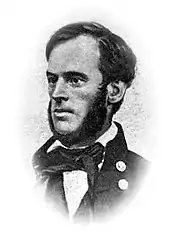
Upon graduation in 1840, Sherman entered the army as a second lieutenant in the 3rd U.S. Artillery and saw action in Florida in the Second Seminole War. In his memoirs he noted that "it was a great pity to remove the Seminoles at all," as Florida "was the Indian's paradise" and still had (at the time that Sherman wrote his memoirs in the 1870s) "a population less than should make a good State."[26] Sherman was later stationed in Georgia and South Carolina. As the foster son of a prominent Whig politician, in Charleston the popular Lieutenant Sherman moved within the upper circles of Old South society.[27]
While many of his colleagues saw action in the Mexican–American War, Sherman was assigned to administrative duties in the captured territory of California. Along with fellow Lieutenants Henry Halleck and Edward Ord, Sherman embarked from New York City on the 198-day journey around Cape Horn, aboard the converted sloop USS Lexington.[28] During that voyage, Sherman grew close to Ord and especially to the intellectually distinguished Halleck.[29] In his memoirs, Sherman relates a hike with Halleck to the summit of Corcovado, overlooking Rio de Janeiro in Brazil, in order to examine the city's aqueduct design.[30][31]
Sherman and Ord disembarked in Monterey, California on January 28, 1847, two days before the town of Yerba Buena acquired the new name of "San Francisco".[32] Sherman and Halleck lived in a house in Monterey, now known as the "Sherman Quarters", from 1847 to 1849.[33] In June 1848, Sherman accompanied the military governor of California, Col. Richard Barnes Mason, to inspect the gold mines at Sutter's Fort.[34][35] Sherman unwittingly helped to launch the California Gold Rush by drafting the official documents in which Governor Mason confirmed that gold had been discovered in the region.[36][37]
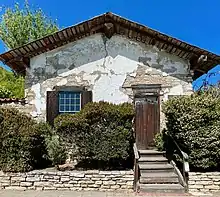
At John Augustus Sutter Jr.’s request, Sherman assisted Capt. William H. Warner in surveying the new city of Sacramento, laying its street grid in 1848.[38] He also opened a general store in Coloma, which earned him $1,500 in 1849 while his army salary was only $70 a month. Sherman also earned money from surveying and by the sale of lots in Sacramento and Benicia.[39]
Sherman earned a brevet promotion to captain for his "meritorious service", but his lack of a combat assignment discouraged him and may have contributed to his decision to resign his commission in 1853. He would eventually become one of the few high-ranking officers of the U.S. Civil War who had not fought in Mexico.[40]
Marriage and business career
In 1850, Sherman was promoted to the substantive rank of captain. On May 1 of that year he married his foster sister, Ellen Boyle Ewing, four years his junior. Father James A. Ryder, president of Georgetown College, officiated at the Washington, D.C., ceremony. President Zachary Taylor, vice president Millard Fillmore and other political luminaries attended. Thomas Ewing was Secretary of the Interior at the time.[41] Ellen Ewing Sherman was a devout Roman Catholic, and the couple's children were reared in that faith.[42]
Their children were:[43]
- Maria Ewing ("Minnie") (1851–1913)
- Mary Elizabeth (1852–1925)
- William Tecumseh Jr. ("Willie") (1854–1863)
- Thomas Ewing (1856–1933)
- Eleanor Mary ("Ellie") (1859–1915)
- Rachel Ewing (1861–1919)
- Charles Celestine (1864–1864)
- Philemon Tecumseh (1867–1941)
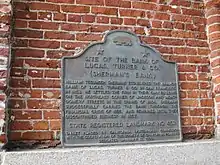
In 1853, Sherman resigned his captaincy and became manager of the San Francisco branch of the Bank of Lucas, Turner & Co., whose corporate headquarters were in St. Louis. Sherman survived two shipwrecks and floated through the Golden Gate on the overturned hull of a foundering lumber schooner.[44] He suffered from asthma attacks, which he attributed in part to stress caused by the city's aggressive business culture.[45][46] Late in life, Sherman recalled his time in a San Francisco gripped by the frenzy of real estate speculation, "I can handle a hundred thousand men in battle, and take the City of the Sun, but am afraid to manage a lot in the swamp of San Francisco."[47] The failure of Page, Bacon & Co. triggered a panic surrounding the "Black Friday" of February 23, 1855, leading to the closure of several of San Francisco's principal banks and many other businesses. Sherman, however, succeeded in keeping his own bank solvent.[48][49] In 1856, during the vigilante period, Sherman served briefly as a major general of the California militia.[50]
Sherman's San Francisco branch closed in May 1857, and he relocated to New York City on behalf of the same bank, travelling on the steamer SS Central America. When the bank failed during the Panic of 1857, he closed the New York branch. In early 1858, he returned to California to finalize the bank's outstanding accounts there.[51][lower-alpha 3] Later in 1858, he moved to Leavenworth, Kansas, where he worked as the office manager of the law firm established by his brothers-in-law Hugh Ewing and Thomas Ewing Jr. Sherman obtained a license to practice law, despite not having studied for the bar, but he met with little success as a lawyer.[52]
Military college superintendent
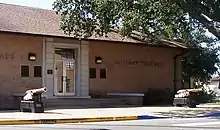
In 1859, Sherman accepted a job as the first superintendent of the Louisiana State Seminary of Learning & Military Academy in Pineville, Louisiana, a position he sought at the suggestion of Major Don Carlos Buell and obtained through the support of General George Mason Graham.[54] Sherman was an effective and popular leader of the institution, which would later become Louisiana State University.[55] Colonel Joseph P. Taylor, brother of the late President Zachary Taylor, declared that "if you had hunted the whole Army, from one end of it to the other, you could not have found a man in it more admirably suited for the position in every respect than Sherman."[56]
Sherman's younger brother John was, from his seat in the U.S. Congress, a prominent advocate against slavery. Before the Civil War, however, the more conservative William T. had expressed some sympathy for the white Southerners' defense of their traditional agrarian system, including the institution of slavery. On the other hand, he was adamantly opposed to the secession of the southern states. In Louisiana, he became a close friend of professor David French Boyd, a native of Virginia and an enthusiastic secessionist. Boyd later recalled witnessing that, when news of South Carolina's secession from the United States reached them at the Seminary, "Sherman burst out crying, and began, in his nervous way, pacing the floor and deprecating the step which he feared might bring destruction on the whole country."[57] In what some authors have seen as an accurate prophecy of the conflict that would engulf the United States during the next four years,[58] Boyd recalled Sherman declaring:
You people of the South don't know what you are doing. This country will be drenched in blood, and God only knows how it will end. It is all folly, madness, a crime against civilization! You people speak so lightly of war; you don't know what you're talking about. War is a terrible thing! You mistake, too, the people of the North. They are a peaceable people but an earnest people, and they will fight, too. They are not going to let this country be destroyed without a mighty effort to save it ... Besides, where are your men and appliances of war to contend against them? The North can make a steam engine, locomotive, or railway car; hardly a yard of cloth or pair of shoes can you make. You are rushing into war with one of the most powerful, ingeniously mechanical, and determined people on Earth—right at your doors. You are bound to fail. Only in your spirit and determination are you prepared for war. In all else you are totally unprepared, with a bad cause to start with. At first you will make headway, but as your limited resources begin to fail, shut out from the markets of Europe as you will be, your cause will begin to wane. If your people will but stop and think, they must see in the end that you will surely fail.[59]
In January 1861, as more Southern states seceded from the Union, Sherman was required to take receipt of arms surrendered to the Louisiana State Militia by the U.S. arsenal at Baton Rouge. Instead of complying, he resigned his position as superintendent, declaring to the governor of Louisiana that "on no earthly account will I do any act or think any thought hostile to or in defiance of the old Government of the United States."[60]
St. Louis interlude
Sherman departed Louisiana and traveled to Washington, D.C., possibly in the hope of securing a position in the U.S. Army. At the White House, Sherman met with Abraham Lincoln a few days after his inauguration as president of the United States. Sherman expressed serious concerns about the North's poor state of preparedness for the looming civil war, but Lincoln was unresponsive to these concerns.[61][62]
Sherman then moved to St. Louis to become president of a streetcar company called the Fifth Street Railroad. Thus, he was living in the border state of Missouri as the secession crisis reached its climax.[63] While trying to hold himself aloof from political controversy, he observed first-hand the efforts of Congressman Frank Blair, who later served under Sherman in the U.S. Army, to keep Missouri in the Union.[64] In early April, Sherman declined Montgomery Blair's offer of the administrative position of chief clerk in the War Department, despite Blair's promise that it would be followed by appointment as Assistant Secretary of War after the U.S. Congress assembled in July.[65][66]
After the April 12–13 bombardment of Fort Sumter and its subsequent capture by the Confederacy, Sherman hesitated about committing to military service and ridiculed Lincoln's call for 75,000 three-month volunteers to quell secession, reportedly saying: "Why, you might as well attempt to put out the flames of a burning house with a squirt-gun."[67] In May, however, he offered himself for service in the regular Army. Senator John Sherman (his younger brother and a political ally of President Lincoln) and other connections in Washington helped him to obtain a commission.[68] On June 3, he wrote that "I still think it is to be a long war—very long—much longer than any Politician thinks."[69]
Civil War service
First commissions and Bull Run
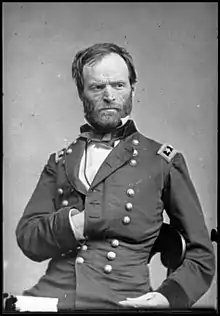
Sherman was first commissioned as colonel of the 13th U.S. Infantry Regiment, effective May 14, 1861. This was a new regiment yet to be raised. In fact, Sherman's first command was a brigade of three-month volunteers who fought in the First Battle of Bull Run on July 21, 1861.[70] It was one of the four brigades in the division commanded by General Daniel Tyler, which was in turn one of the five divisions in the Army of Northeastern Virginia under General Irvin McDowell (see First Bull Run Union order of battle).[71]
The engagement at Bull Run ended in a disastrous defeat for the Union, dashing the hopes for a rapid resolution of the conflict over secession. Sherman was one of the few Union officers to distinguish himself in the field and historian Donald L. Miller has characterized Sherman's performance at Bull Run as "exemplary".[72] During the fighting, Sherman was grazed by bullets in the knee and shoulder. According to British military historian Brian Holden-Reid, "if Sherman had committed tactical errors during the attack, he more than compensated for these during the subsequent retreat".[73] Holden-Reid also concluded that Sherman "might have been as unseasoned as the men he commanded, but he had not fallen prey to the naïve illusions nursed by so many on the field of First Bull Run."[74]
The outcome at Bull Run caused Sherman to question his own judgment as an officer and the capabilities of his volunteer troops. However, Sherman impressed Lincoln during the President's visit to the troops on July 23, and Lincoln promoted Sherman to brigadier general of volunteers effective May 17, 1861. This made Sherman senior in rank to Ulysses S. Grant, his future commander.[75] Sherman was then assigned to serve under Robert Anderson in the Department of the Cumberland, in Louisville, Kentucky. In October, Sherman succeeded Anderson in command of that department. In his memoirs, Sherman would later write that he saw that new assignment as breaking a promise by President Lincoln that he would not be given such a prominent leadership position.[76]
Kentucky and breakdown
Having succeeded Anderson at Louisville, Sherman now had principal military responsibility for Kentucky, a border state in which the Confederates held Columbus and Bowling Green, and were also present near the Cumberland Gap.[lower-alpha 4] He became exceedingly pessimistic about the outlook for his command and he complained frequently to Washington about shortages, while providing exaggerated estimates of the strength of the rebel forces and requesting inordinate numbers of reinforcements. Critical press reports about Sherman began to appear after the U.S. Secretary of War, Simon Cameron, visited Louisville in October 1861. In early November, Sherman asked to be relieved of his command.[77][78] He was promptly replaced by Don Carlos Buell and transferred to St. Louis. In December, he was put on leave by Henry W. Halleck, commander of the Department of the Missouri, who considered him unfit for duty. Sherman went to Lancaster, Ohio, to recuperate. While he was at home, his wife Ellen wrote to his brother, Senator John Sherman, seeking advice. She complained of "that melancholy insanity to which your family is subject".[79] In his private correspondence, Sherman later wrote that the concerns of command "broke me down" and admitted to having contemplated suicide.[80] His problems were compounded when the Cincinnati Commercial described him as "insane".[81]
By mid-December 1861 Sherman had recovered sufficiently to return to service under Halleck in the Department of the Missouri. In March, Halleck's command was redesignated the Department of the Mississippi and enlarged to unify command in the West. Sherman's initial assignments were rear-echelon commands, first of an instructional barracks near St. Louis and then in command of the District of Cairo.[82] Operating from Paducah, Kentucky, he provided logistical support for the operations of Grant to capture Fort Donelson in February 1862. Grant, the previous commander of the District of Cairo, had just won a major victory at Fort Henry and been given command of the ill-defined District of West Tennessee. Although Sherman was technically the senior officer, he wrote to Grant, "I feel anxious about you as I know the great facilities [the Confederates] have of concentration by means of the River and R[ail] Road, but [I] have faith in you—Command me in any way."[83][84]
Shiloh
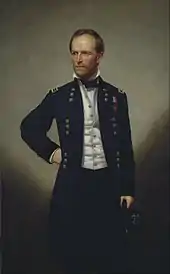
After Grant captured Fort Donelson, Sherman got his wish to serve under Grant when he was assigned on March 1, 1862, to the Army of West Tennessee as commander of the 5th Division.[85] His first major test under Grant was at the Battle of Shiloh. The massive Confederate attack on the morning of April 6, 1862, took most of the senior Union commanders by surprise. Sherman had dismissed the intelligence reports from militia officers, refusing to believe that Confederate general Albert Sidney Johnston would leave his base at Corinth. He took no precautions beyond strengthening his picket lines, and refused to entrench, build abatis, or push out reconnaissance patrols. At Shiloh, he may have wished to avoid appearing overly alarmed in order to escape the kind of criticism he had received in Kentucky. Indeed, he had written to his wife that if he took more precautions "they'd call me crazy again".[86]
Despite being caught unprepared by the attack, Sherman rallied his division and conducted an orderly, fighting retreat that helped avert a disastrous Union rout. Finding Grant at the end of the day sitting under an oak tree in the darkness and smoking a cigar, Sherman felt, in his words, "some wise and sudden instinct not to mention retreat". In what would become one of the most notable conversations of the war, Sherman said simply: "Well, Grant, we've had the devil's own day, haven't we?" After a puff of his cigar, Grant replied calmly: "Yes. Lick 'em tomorrow, though."[87] Sherman proved instrumental to the successful Union counterattack of April 7, 1862. At Shiloh, Sherman was wounded twice—in the hand and shoulder—and had three horses shot out from under him. His performance was praised by Grant and Halleck and after the battle he was promoted to major general of volunteers, effective May 1, 1862.[85]
Beginning in late April, a Union force of 100,000 moved slowly against Corinth, under Halleck's leadership and with Grant relegated to second-in-command. Sherman commanded the division on the extreme right of the Union's right wing (under George Henry Thomas). Shortly after the Union forces occupied Corinth on May 30, Sherman persuaded Grant not to resign from his command, despite the serious difficulties he was having with Halleck. Sherman offered Grant an example from his own life: "Before the battle of Shiloh, I was cast down by a mere newspaper assertion of 'crazy', but that single battle gave me new life, and I'm now in high feather." He told Grant that, if he remained in the army, "some happy accident might restore you to favor and your true place".[88][89] In July, Grant's situation improved when Halleck left for the East to become general-in-chief. Sherman then became the military governor of occupied Memphis.[90]
Vicksburg
On November 1862, U. S. Grant, acting as commander of the Union forces in the state of Mississippi, launched a campaign to capture the city of Vicksburg, the principal Confederate stronghold along the Mississippi River.[91] Grant made Sherman a corps commander and put him in charge of half of his forces.[92] According to historian John D. Winters's The Civil War in Louisiana (1963), at this stage Sherman
had yet to display any marked talents for leadership. Sherman, beset by hallucinations and unreasonable fears and finally contemplating suicide, had been relieved from command in Kentucky. He later began a new climb to success at Shiloh and Corinth under Grant. Still, if he muffed his Vicksburg assignment, which had begun unfavorably, he would rise no higher. As a man, Sherman was an eccentric mixture of strength and weakness. Although he was impatient, often irritable and depressed, petulant, headstrong, and unreasonably gruff, he had solid soldierly qualities. His men swore by him, and most of his fellow officers admired him.[93]
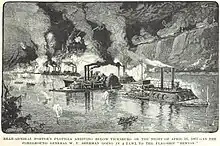
In December, Sherman's forces suffered a severe repulse at the Battle of Chickasaw Bayou, just north of Vicksburg.[94] Sherman's operations were supposed to be coordinated with an advance on Vicksburg by Grant from another direction. Unbeknownst to Sherman, Grant abandoned his advance, and Sherman's river expedition met more resistance than expected.[95] Soon after, Major General John A. McClernand ordered Sherman's XV Corps to join in his assault on Arkansas Post.[96] Grant, who was on poor terms with McClernand, regarded this as a politically motivated distraction from the efforts to take Vicksburg, but Sherman had targeted Arkansas Post independently and considered the operation worthwhile.[97][98] Arkansas Post was taken by the Union army and navy on January 11, 1863.[99]
The failure of the first phase of the campaign against Vicksburg led Grant to formulate an unorthodox new strategy, which called for the invading Union army to separate from its supply train and subsist by foraging.[100] Sherman initially expressed reservations about the wisdom of these plans, but he soon submitted to Grant's leadership and the campaign in the spring of 1863 cemented Sherman's personal ties to Grant.[101] The bulk of Grant's forces were now organized into three corps: the XIII Corps under McClernand, the XV Corps under Sherman, and the XVII Corps under Sherman's young protégé, Maj. Gen. James B. McPherson.[102] During the long and complicated maneuvers against Vicksburg, one newspaper complained that the "army was being ruined in mud-turtle expeditions, under the leadership of a drunkard [Grant], whose confidential adviser [Sherman] was a lunatic".[103] When Vicksburg fell on July 4, 1863, after a prolonged siege, the Union achieved a major strategic victory, putting navigation along the Mississippi River entirely under Union control and effectively cutting off the western half of the Confederacy from the eastern half.[104]
During the siege of Vicksburg, Confederate general Joseph E. Johnston had gathered a force of 30,000 men in Jackson, Mississippi, with the intention of relieving the garrison under the command of John C. Pemberton that was trapped inside Vicksburg. After Pemberton surrendered to Grant on July 4, Johnston advanced towards the rear of Grant's forces. In response to this threat, Grant instructed Sherman to attack Johnston. Sherman conducted the ensuing Jackson Expedition, which concluded successfully on July 25 with the re-capture of the city of Jackson. This helped ensure that the Mississippi River would remain in Union hands for the remainder of the war. According to Holden-Reid, Sherman finally "had cut his teeth as an army commander" with the Jackson Expedition.[105]
Chattanooga
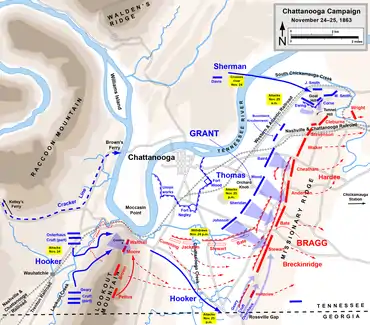
After the surrender of Vicksburg and the re-capture of Jackson, Sherman was given the rank of brigadier general in the regular army, in addition to his rank as a major general of volunteers.[106] His family traveled from Ohio to visit him at the camp near Vicksburg. Sherman's nine-year-old son, Willie, the "Little Sergeant", died from typhoid fever contracted during the trip.[107][108]
Ordered to relieve the Union forces besieged in the city of Chattanooga, Tennessee, Sherman departed from Memphis on October 11, 1863, aboard a train bound for Chattanooga. When Sherman's train passed Collierville it came under attack by 3,000 Confederate cavalry and eight guns under James Ronald Chalmers. Sherman took command of the infantrymen in the local Union garrison and successfully repelled the Confederate attack.[109] Following the defeat of the Army of the Cumberland at the Battle of Chickamauga by Confederate general Braxton Bragg's Army of Tennessee, President Lincoln re-organized the Union forces in the West as the Military Division of the Mississippi, placing it under General Grant's command. Sherman then succeeded Grant at the head of the Army of the Tennessee.[110]
At Chattanooga, Grant instructed Sherman to attack the right flank of Bragg's forces, which were entrenched along Missionary Ridge overlooking the city. On November 25, Sherman took his assigned target of Billy Goat Hill at the north end of the ridge, only to find that it was separated from the main spine by a rock-strewn ravine. When he attempted to attack the main spine at Tunnel Hill, his troops were repeatedly repelled by Patrick Cleburne's heavy division, the best unit in Bragg's army. Grant then ordered Thomas to attack at the center of the Confederate line. This frontal assault was intended as a diversion, but it unexpectedly succeeded in capturing the enemy's entrenchments and routing the Confederate Army of Tennessee, bringing the Union's Chattanooga campaign to a successful completion.[111]
After Chattanooga, Sherman led a column to relieve Union forces under Ambrose Burnside thought to be in peril at Knoxville. In February 1864, he led an expedition to Meridian, Mississippi, intended to disrupt Confederate infrastructure and communications.[112][113] Sherman's army captured the city of Meridian on February 14 and proceeded to destroy 105 miles of railroad and 61 bridges, while burning at least 10 locomotives and 28 railcars. The army took 4,000 prisoners and commandeered many wagons and horses. Thousands of refugees, both black and white, joined Sherman's columns, which on February 20 finally withdrew towards Canton.[114]
Atlanta
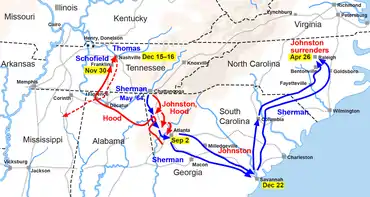
The Meridian campaign marked the end of Sherman's brief tenure as commander of the Army of the Tennessee. Sherman had, up to that point, achieved mixed success as a general, and controversy attached especially to his performance at Chattanooga.[115] However, he enjoyed Grant's confidence and friendship.[116] When Lincoln called Grant east in the spring of 1864 to take command of all the Union armies, Grant appointed Sherman (by then known to his soldiers as "Uncle Billy") to succeed him as head of the Military Division of the Mississippi, which entailed command of Union troops in the Western Theater of the war.[117] As Grant took overall command of the armies of the United States, Sherman wrote to him outlining his strategy to bring the war to an end: "If you can whip Lee and I can march to the Atlantic I think ol' Uncle Abe [Lincoln] will give us twenty days leave to see the young folks."[118]
Sherman proceeded to invade the state of Georgia with three armies: the 60,000-strong Army of the Cumberland under Thomas, the 25,000-strong Army of the Tennessee under James B. McPherson, and the 13,000-strong Army of the Ohio under John M. Schofield.[119] He conducted a series of flanking maneuvers through rugged terrain against Confederate general Joseph E. Johnston's Army of Tennessee, attempting a direct assault only at the Battle of Kennesaw Mountain. The Confederate victory at Kennesaw Mountain did little to halt Sherman's advance towards Atlanta.[120] In July, the cautious Johnston was replaced by the more aggressive John Bell Hood, who played to Sherman's strength by challenging him to direct battles on open ground.[121][122] Meanwhile, in August, Sherman "learned that I had been commissioned a major-general in the regular army, which was unexpected, and not desired until successful in the capture of Atlanta".[123][lower-alpha 5]
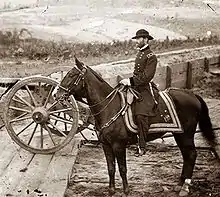
Sherman's Atlanta campaign concluded successfully on September 2, 1864, with the capture of the city, which Hood had been forced to abandon. After ordering almost all civilians to abandon the city in September, Sherman gave instructions that all military and government buildings in Atlanta be burned, although many private homes and shops were burned as well.[125]
The capture of Atlanta made Sherman a household name and was decisive in ensuring Lincoln's re-election in November.[126] Sherman's success caused the collapse of the once powerful "Copperhead" faction within the Democratic Party, which had advocated immediate peace negotiations with the Confederacy. It also dealt a major blow to the popularity of the Democratic presidential candidate, George B. McClellan, whose victory in the election had until then appeared likely to many, including Lincoln himself.[126] According to Holden-Reid, "Sherman did more than any other man apart from the president in creating [the] climate of opinion" that afforded Lincoln a comfortable victory over McClellan at the polls.[127]
March to the Sea
During September and October, Sherman and Hood played a cat-and-mouse game in northern Georgia and Alabama, as Hood threatened Sherman's communications to the north. Eventually, Sherman won approval from his superiors for a plan to cut loose from his communications and march south, having advised Grant that he could "make Georgia howl".[128] In response, Hood moved north into Tennessee. Sherman at first trivialized the corresponding threat, reportedly saying that he would "give [Hood] his rations" to go in that direction, as "my business is down south".[129][130] Sherman left forces under Maj. Gens. George H. Thomas and John M. Schofield to deal with Hood; their forces eventually smashed Hood's army in the battles of Franklin (November 30) and Nashville (December 15–16).[131]
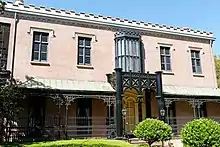
After November elections, Sherman began marching on November 15 with 62,000 men in the direction of the port city of Savannah, Georgia,[132] living off the land and causing, by his own estimate, more than $100 million in property damage.[133] At the end of this campaign, known as Sherman's March to the Sea, his troops took Savannah on December 21, 1864.[134] Upon reaching Savannah, Sherman appointed Private A. O. Granger as his personal secretary.[135] Sherman then dispatched a message to Lincoln, offering him the city as a Christmas present.[136][lower-alpha 6]
Sherman's success in Georgia received ample coverage in the Northern press at a time when Grant seemed to be making little progress in his fight against Confederate general Robert E. Lee's Army of Northern Virginia. A bill was introduced in Congress to promote Sherman to Grant's rank of lieutenant general, probably with a view towards having him replace Grant as commander of the Union Army. Sherman wrote both to his brother, Senator John Sherman, and to General Grant vehemently repudiating any such promotion.[138] According to a war-time account, it was around this time that Sherman made his memorable declaration of loyalty to Grant:
General Grant is a great general. I know him well. He stood by me when I was crazy, and I stood by him when he was drunk; and now, sir, we stand by each other always.[139]
While in Savannah, Sherman learned from a newspaper that his infant son Charles Celestine had died during the Savannah campaign; the general had never seen the child.[140]
Final campaigns in the Carolinas
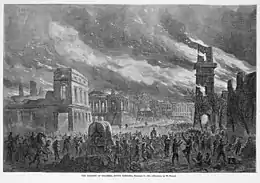
Grant then ordered Sherman to embark his army on steamers and join the Union forces confronting Lee in Virginia, but Sherman instead persuaded Grant to allow him to march north through the Carolinas, destroying everything of military value along the way, as he had done in Georgia. He was particularly interested in targeting South Carolina, the first state to secede from the Union, because of the effect that it would have on Southern morale.[141][142] His army proceeded north through South Carolina against light resistance from the troops of Confederate general Johnston. Upon hearing that Sherman's men were advancing on corduroy roads through the Salkehatchie swamps at a rate of a dozen miles per day, Johnston "made up his mind that there had been no such army in existence since the days of Julius Caesar".[143]
Sherman captured Columbia, the state capital, on February 17, 1865. Fires began that night and by next morning most of the central city was destroyed. The burning of Columbia has engendered controversy ever since, with some claiming the fires were a deliberate act of vengeance by the Union troops and others that the fires were accidental, caused in part by the burning bales of cotton that the retreating Confederates left behind them.[144]
Local Native American Lumbee guides helped Sherman's army cross the Lumber River, which was flooded by torrential rains, into North Carolina. According to Sherman, the trek across the Lumber River, and through the swamps, pocosins, and creeks of Robeson County was "the damnedest marching I ever saw".[145] Thereafter, his troops did relatively little damage to the civilian infrastructure. North Carolina, unlike its southern neighbor, was regarded by the Union troops as a reluctant Confederate state,[146] having been second from last to secede from the Union, ahead only of Tennessee.
The only general engagement during Sherman's marches through Georgia and the Carolinas, the Battle of Bentonville, took place on March 19–21, 1865.[147] Having defeated the Confederate forces under Johnston at Bentonville, Sherman proceeded to rendezvous at Goldsboro with the Union troops that awaited him there after the captures of the coastal cities of New Bern and Wilmington.[148]

In late March, Sherman briefly left his forces and traveled to City Point, Virginia, to confer with Grant. Lincoln happened to be at City Point at the same time, making possible the only three-way meeting of Lincoln, Grant, and Sherman during the war.[149][150] Also present at the City Point conference was Rear Admiral David Dixon Porter. This meeting was memorialized in G. P. A. Healy's painting The Peacemakers.[151] After returning to Goldsboro, Sherman marched with his troops to the state capital, Raleigh, where Sherman sought to communicate with Johnston's army regarding possible terms for ending the war. On April 9, Sherman relayed to his troops the news that Lee had surrendered to Grant at Appomattox Court House and that the Confederate Army of Northern Virginia had ceased to exist.[152]
Confederate surrender
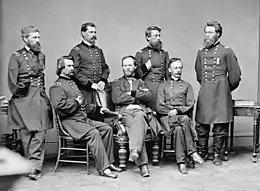
Following Lee's surrender and the assassination of Lincoln, Sherman met with Johnston on April 17, 1865, at Bennett Place in Durham, North Carolina, to negotiate a Confederate surrender. At the insistence of Johnston, Confederate president Jefferson Davis, and Confederate Secretary of War John C. Breckinridge, Sherman conditionally agreed to generous terms that dealt with both military and political issues. On April 20, Sherman dispatched a memorandum with those terms to the government in Washington.[153]
Sherman believed that the terms that he had agreed to were consistent with the views that Lincoln had expressed at City Point, and that they offered the best way to prevent Johnston from ordering his men to go into the wilderness and conduct a destructive guerrilla campaign. However, Sherman had proceeded without authority from Grant, the newly installed President Andrew Johnson, or the Cabinet. The assassination of Lincoln had caused the political climate in Washington to turn against the prospect of a rapid reconciliation with the defeated Confederates and the Johnson administration rejected Sherman's terms. Grant may have had to intervene to save Sherman from dismissal for having overstepped his authority.[154] The U.S. Secretary of War, Edwin M. Stanton, leaked Sherman's memorandum to The New York Times, intimating that Sherman might have been bribed to allow Davis to escape capture by the Union troops.[155] This precipitated a deep and long-lasting enmity between Sherman and Stanton, and it intensified Sherman's disdain for politicians.[156]
Grant then offered Johnston purely military terms, similar to those that he had negotiated with Lee at Appomattox. Johnston, ignoring instructions from President Davis, accepted those terms on April 26, 1865, formally surrendered his army and all the Confederate forces in the Carolinas, Georgia, and Florida. This was the largest single capitulation of the war.[157] Sherman proceeded with some of his troops to Washington, where they marched in the Grand Review of the Armies on May 24, 1865.[158]
Slavery and emancipation
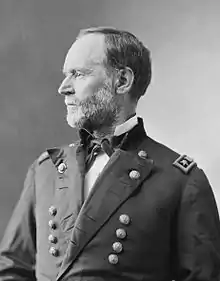
Sherman was not an abolitionist before the war and, like others of his time and background, he did not believe in "Negro equality".[159][160][161] Before the war, Sherman expressed some sympathy with the view of Southern whites that the black race was benefiting from slavery, although he opposed breaking up slave families and advocated that the laws forbidding the education of slaves be repealed.[162][163][164] Throughout the Civil War, Sherman declined to employ black troops in his armies.[165][166]
In his Memoirs, Sherman commented on the political pressures of 1864–1865 to encourage the escape of slaves, in part to avoid the possibility that "able-bodied slaves will be called into the military service of the rebels".[167] Sherman rejected this, arguing that focusing on such policies would have delayed the "successful end" of the war and the "[liberation of] all slaves",[168] adding that
My aim then was to whip the rebels, to humble their pride, to follow them to their inmost recesses, and make them fear and dread us. "Fear of the Lord is the beginning of wisdom." I did not want them to cast in our teeth what General Hood had once done at Atlanta, that we had to call on their slaves to help us to subdue them.[168]
Tens of thousands of escaped slaves nonetheless joined Sherman's marches through Georgia and the Carolinas as refugees,[169] and their fate soon became a pressing military and political issue.[170] Some abolitionists accused Sherman of doing little to alleviate the precarious living conditions of these refugees, motivating Secretary of War Stanton to travel to Georgia in January 1865 to investigate the situation.[171] On January 12, Sherman and Stanton met in Savannah with twenty local black leaders, most of them Baptist or Methodist ministers, invited by Sherman.[172][173] According to historian Eric Foner, "the 'Colloquy' between Sherman, Stanton, and the black leaders offered a rare lens through which the experience of slavery and the aspirations that would help to shape Reconstruction came into sharp focus."[169]
After Sherman's departure the spokesman for the black leaders, Baptist minister Garrison Frazier,[174][175] declared in response to Stanton's inquiry about the feelings of the black community:
We looked upon General Sherman prior to his arrival as a man in the providence of God specially set apart to accomplish this work, and we unanimously feel inexpressible gratitude to him, looking upon him as a man that should be honored for the faithful performance of his duty. Some of us called upon him immediately upon his arrival, and it is probable he would not meet the Secretary [Stanton] with more courtesy than he met us. His conduct and deportment toward us characterized him as a friend and a gentleman.[175]
Four days later, Sherman issued his Special Field Orders, No. 15. The orders provided for the settlement of 40,000 freed slaves and black refugees on land expropriated from white landowners in South Carolina, Georgia, and Florida. Sherman appointed Brig. Gen. Rufus Saxton, an abolitionist from Massachusetts who had previously directed the recruitment of black soldiers, to implement that plan.[176][177] Those orders, which became the basis of the claim that the Union government had promised freed slaves "forty acres and a mule", were revoked later that year by President Johnson.[178]
Towards the end of the Civil War, some elements within the Republican Party regarded Sherman as being strongly prejudiced against black people.[166] However, Sherman's views on race evolved significantly over time. He dealt in a friendly and unaffected way with the black people that he met during his career.[179][180] In 1888, near the end of his life, Sherman published an essay in the North American Review defending the full civil rights of black citizens in the former Confederacy.[181][182][183] In that essay, Sherman called upon the South to "let the negro vote, and count his vote honestly", adding that "otherwise, so sure as there is a God in Heaven, you will have another war, more cruel than the last, when the torch and dagger will take the place of muskets and well-ordered battalions".[181][184]
Strategies
Sherman's record as a tactician was mixed, and his military legacy rests primarily on his command of logistics and on his brilliance as a strategist. The influential 20th-century British military historian and theorist B. H. Liddell Hart ranked Sherman as "the first modern general" and one of the most important strategists in the annals of war, along with Scipio Africanus, Belisarius, Napoleon Bonaparte, T. E. Lawrence, and Erwin Rommel.[7] Liddell Hart's views on the historical significance of Sherman have since been discussed and, to varying extents, defended by subsequent military scholars such as Jay Luvaas,[185] Victor Davis Hanson,[186] and Brian Holden-Reid.[187]
Maneuver warfare
Liddell Hart credited Sherman with mastery of maneuver warfare, also known as the "indirect approach". In maneuver warfare, a commander seeks to defeat the enemy on the battleground through shock, disruption, and surprise, while minimizing frontal attacks on well-defended positions. According to Liddell Hart, this strategy was most clearly illustrated by Sherman's series of turning movements against Johnston during the Atlanta campaign.[188] Liddell Hart also declared that the study of Sherman's campaigns had contributed significantly to his own "theory of strategy and tactics in mechanized warfare", and claimed that this had in turn influenced Heinz Guderian's doctrine of Blitzkrieg and Rommel's use of tanks during the Second World War.[189][190][lower-alpha 7] Another World War II-era student of Liddell Hart's writings on Sherman was General George S. Patton,[191] who "spent a long vacation studying Sherman's campaigns on the ground in Georgia and the Carolinas, with the aid of [Liddell Hart's] book" and later "carried out his [bold] plans, in super-Sherman style".[192]
Hard war
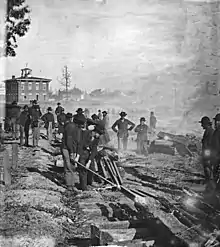
Like Grant and Lincoln, Sherman was convinced that the Confederacy's strategic, economic, and psychological ability to wage further war needed to be definitively crushed if the fighting were to end. Therefore, he believed that the North had to conduct its campaign as a war of conquest, employing scorched earth tactics to break the backbone of the rebellion. Historian Mark Grimsley promoted the use of the term "hard war" to refer to this strategy in the context of the U.S. Civil War.[193][194][lower-alpha 8] Sherman's advance through Georgia and the Carolinas was characterized by widespread destruction of civilian supplies and infrastructure. This strategy has been characterized by some military historians as an early form of total war, although the appropriateness of that term has been questioned by other scholars. Holden-Reid, for instance, argued that "the concept of 'total war' is deeply flawed, an imprecise label that at best describes the two world wars but is of dubious relevance to the U.S. Civil War."[196]
The damage done by Sherman's marches through Georgia and the Carolinas was almost entirely limited to the destruction of property. Looting was officially forbidden, but historians disagree on how rigorously this regulation was enforced.[197][198] Though exact figures are not available, the loss of civilian life appears to have been very small.[199] Consuming supplies, wrecking infrastructure, and undermining morale were Sherman's stated goals, and several of his Southern contemporaries noted this and commented on it.[200] For instance, Alabama-born Major Henry Hitchcock, who served in Sherman's staff, declared that "it is a terrible thing to consume and destroy the sustenance of thousands of people," but if the scorched earth strategy served "to paralyze their husbands and fathers who are fighting ... it is mercy in the end".[201] One of Sherman's tactics was to destroy railways by pulling up the rails, heating them over a bonfire, and twisting them to leave behind what came to known as "Sherman's neckties".[202] This made repairs extremely difficult at a time when the Confederacy lacked both iron and heavy machinery.[203]
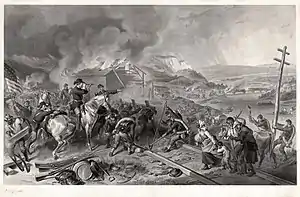
The severity of the destructive acts by Union troops was significantly greater in South Carolina than in Georgia or North Carolina. This appears to have been a consequence of the animosity among both Union soldiers and officers to the state that they regarded as the "cockpit of secession".[204] One of the most serious accusations against Sherman was that he allowed his troops to burn the city of Columbia. Some pro-Confederate sources have repeated a claim that Oliver Otis Howard, the commander of Sherman's 15th Corps, said in 1867 that "It is useless to deny that our troops burnt Columbia, for I saw them in the act."[205][206] Sherman himself stated that "[i]f I had made up my mind to burn Columbia I would have burnt it with no more feeling than I would a common prairie dog village; but I did not do it ..."[207] Sherman's official report on the burning placed the blame on Confederate lieutenant general Wade Hampton, who Sherman said had ordered the burning of cotton in the streets. In his memoirs, Sherman said, "In my official report of this conflagration, I distinctly charged it to General Wade Hampton, and confess I did so pointedly, to shake the faith of his people in him, for he was in my opinion boastful, and professed to be the special champion of South Carolina."[208] Historian James M. McPherson has concluded that:
The fullest and most dispassionate study of this controversy blames all parties in varying proportions—including the Confederate authorities for the disorder that characterized the evacuation of Columbia, leaving thousands of cotton bales on the streets (some of them burning) and huge quantities of liquor undestroyed ... Sherman did not deliberately burn Columbia; a majority of Union soldiers, including the general himself, worked through the night to put out the fires.[209]
In this general connection, it is also noteworthy that Sherman and his subordinates (particularly John A. Logan) took steps to protect Raleigh, North Carolina, from acts of revenge after the assassination of Lincoln.[210][211]
Modern assessment
After the fall of Atlanta in 1864, Sherman ordered the city's evacuation.[212] When the city council appealed to him to rescind that order, on the grounds that it would cause great hardship to women, children, the elderly, and others who bore no responsibility for the conduct of the war,[212][213] Sherman sent a written response in which he sought to articulate his conviction that a lasting peace would be possible only if the Union were restored, and that he was therefore prepared to do all he could do to quash the rebellion:
You cannot qualify war in harsher terms than I will. War is cruelty, and you cannot refine it; and those who brought war into our country deserve all the curses and maledictions a people can pour out. I know I had no hand in making this war, and I know I will make more sacrifices to-day than any of you to secure peace. But you cannot have peace and a division of our country. If the United States submits to a division now, it will not stop, but will go on until we reap the fate of Mexico, which is eternal war ... I want peace, and believe it can only be reached through union and war, and I will ever conduct war with a view to perfect and early success.[214]
Literary critic Edmund Wilson found in Sherman's Memoirs a fascinating and disturbing account of an "appetite for warfare" that "grows as it feeds on the South".[215] Former U.S. Defense Secretary Robert McNamara refers equivocally to the statement that "war is cruelty and you cannot refine it" in both the book Wilson's Ghost[216] and in his interview for the documentary film The Fog of War (2003).
When comparing Sherman's scorched-earth campaigns to the actions of the British Army during the Second Boer War (1899–1902) —another war in which civilians were targeted because of their central role in sustaining a belligerent power— South African historian Hermann Giliomee claims that it "looks as if Sherman struck a better balance than the British commanders between severity and restraint in taking actions proportional to legitimate needs".[217] The admiration of scholars such as B. H. Liddell Hart,[218] Lloyd Lewis, Victor Davis Hanson,[219] John F. Marszalek,[220] and Brian Holden-Reid[221] for Sherman owes much to what they see as an approach to the exigencies of modern armed conflict that was both effective and principled.[lower-alpha 9]
Postbellum service
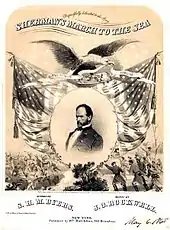
In May 1865, after the major Confederate armies had surrendered, Sherman wrote in a personal letter:
I confess, without shame, I am sick and tired of fighting—its glory is all moonshine; even success the most brilliant is over dead and mangled bodies, with the anguish and lamentations of distant families, appealing to me for sons, husbands and fathers ... tis only those who have never heard a shot, never heard the shriek and groans of the wounded and lacerated ... that cry aloud for more blood, more vengeance, more desolation.[223][lower-alpha 10]
In June 1865, two months after Lee's surrender at Appomattox, Sherman received his first postwar command, originally called the Military Division of the Mississippi, later the Military Division of the Missouri, which came to comprise the territory between the Mississippi River and the Rocky Mountains. Sherman's efforts in that position were focused on protecting the main wagon roads, such as the Oregon, Bozeman and Santa Fe Trails.[225] Tasked with guarding a vast territory with limited forces, Sherman grew weary of the multitude of requests for military protection addressed to him.[225] On July 25, 1866, the U.S. Congress created the new rank of General of the Army for Grant, while also promoting Sherman to Grant's previous rank of lieutenant general.[226]
Indian Wars
There was little large-scale military action against the Indians during the first three years of Sherman's tenure as divisional commander, as Sherman allowed negotiations between the U.S. government and Indian leaders to proceed, while he built up his troops and awaited completion of the Union Pacific and Kansas Pacific Railroads. During this time he was a member of the Indian Peace Commission. Though the commission was responsible for the negotiation of the Medicine Lodge Treaty and the Treaty of Fort Laramie, Sherman did not play a significant role in the drafting of those treaties because in both cases he was called away to Washington during the negotiations.[227] In one instance, he was summoned to testify as a witness in Andrew Johnson's impeachment trial.[228] He testified in the trial on April 11 and 13, 1868.[229] He was successful in negotiating other treaties, such as the removal of Navajos from the Bosque Redondo to traditional lands in Western New Mexico.[228]
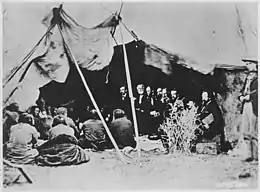
When the Medicine Lodge Treaty was broken in 1868, Sherman authorized his subordinate in Missouri, Major General Philip Sheridan, to lead the winter campaign of 1868–69, of which the Battle of Washita River was part. Sheridan used hard-war tactics similar to those he and Sherman had employed in the Civil War.[230] In 1871, Sherman ordered that the leaders of the Warren Wagon Train Raid, an attack by a Kiowa and Comanche war party from which Sherman himself had narrowly escaped, be tried for murder in Jacksboro, Texas. The resulting trial of Satanta and Big Tree marked the first occasion in which Native American chiefs were tried by a civilian court in the United States.[231]
Sherman regarded the expansion of the railroad system "as the most important element now in progress to facilitate the military interests of our Frontier".[232] One of the main concerns of his postbellum service was, therefore, to protect the construction and operation of the railroads from hostile Indians.[233] Sherman's views on Indian matters were often strongly expressed. Following the 1866 Fetterman Massacre, in which 81 U.S. soldiers were ambushed and killed by Native American warriors, Sherman telegraphed Grant that "we must act with vindictive earnestness against the Sioux, even to their extermination, men, women and children."[234] In 1867, he wrote to Grant that "we are not going to let a few thieving, ragged Indians check and stop the progress" of the railroads.[235] In 1873, Sherman wrote in a private letter that "during an assault, the soldiers can not pause to distinguish between male and female, or even discriminate as to age. As long as resistance is made[,] death must be meted out, but the moment all resistance ceases, the firing will stop and all survivors turned over to the proper Indian agent".[236]
Displacement of the Plains Indians was facilitated by the growth of the railroads and the eradication of the bison. Sherman believed that bison eradication should be encouraged as a means of weakening Indian resistance to assimilation. He voiced this view in remarks to a joint session of the Texas legislature in 1875, although the U.S. Army under Sherman's command never conducted its own program of bison extermination.[237][238] Sherman encouraged bison hunting by private citizens and, when Congress passed a law in 1874 to protect the bison from over-hunting, Sherman helped convince President Grant to use a pocket veto to prevent it from coming into force.[239]
General of the Army
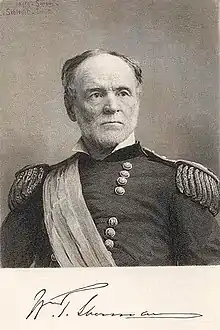
When Grant became president in 1869, Sherman was appointed Commanding General of the United States Army and promoted to the rank of full general. After the death of John A. Rawlins, Sherman also served for one month as acting Secretary of War.[241]
Sherman's early tenure as Commanding General was marred by political difficulties, many of which stemmed from disagreements with Secretary of War Rawlins and his successor, William W. Belknap, both of whom Sherman felt had assumed too much power over the army and reduced the position of Commanding General to a sinecure.[225] Sherman also clashed with Eastern humanitarians who were critical of the army's harsh treatment of the Indians and who had apparently found an ally in President Grant.[225] To escape from these difficulties, Sherman moved his headquarters to St. Louis in 1874. He returned to Washington in 1876, when the new Secretary of War, Alphonso Taft, promised him greater authority.[242]
Much of Sherman's time as Commanding General was devoted to making the Western and Plains states safe for settlement through the continuation of the Indian Wars, which included three significant campaigns: the Modoc War, the Great Sioux War of 1876, and the Nez Perce War. Despite his harsh treatment of the warring tribes, Sherman spoke out against speculators and government agents who abused the Native Americans living within the reservations.[243][244] During this time, Sherman also reorganized the U.S. Army forts to better accommodate the shifting frontier.[245]
In 1875, ten years after the end of the Civil War, Sherman became one of the first Civil War generals to publish his memoirs.[246] The Memoirs of General William T. Sherman. By Himself, published by D. Appleton & Company in two volumes, began with the year 1846 (when the Mexican War began) and ended with a chapter about the "military lessons of the [civil] war". The publication of Sherman's memoirs sparked controversy and drew complaints from many quarters.[247][lower-alpha 11] Grant, who was president when Sherman's memoirs appeared, later remarked that others had told him that Sherman treated Grant unfairly but "when I finished the book, I found I approved every word; that ... it was a true book, an honorable book, creditable to Sherman, just to his companions—to myself particularly so—just such a book as I expected Sherman would write."[250]
According to critic Edmund Wilson, Sherman:
[H]ad a trained gift of self-expression and was, as Mark Twain says, a master of narrative. [In his Memoirs] the vigorous account of his pre-war activities and his conduct of his military operations is varied in just the right proportion and to just the right degree of vivacity with anecdotes and personal experiences. We live through his campaigns ... in the company of Sherman himself. He tells us what he thought and what he felt, and he never strikes any attitudes or pretends to feel anything he does not feel.[251]

During the election of 1876, Southern Democrats who supported Wade Hampton for governor used mob violence to attack and intimidate African American voters in Charleston. Republican Governor Daniel Henry Chamberlain appealed to President Grant for military assistance. In October 1876, Grant, after issuing a proclamation, instructed Sherman to gather all available Atlantic region troops and dispatch them to South Carolina to stop the mob violence.[252]
On June 19, 1879, Sherman delivered an address to the graduating class of the Michigan Military Academy, in which he may have uttered the famous phrase "War is Hell".[253] On April 11, 1880, he addressed a crowd of more than 10,000 in Columbus, Ohio: "There is many a boy here today who looks on war as all glory, but, boys, it is all hell."[254]
One of Sherman's significant contributions as head of the Army was the establishment of the Command School (now the Command and General Staff College) at Fort Leavenworth[255] in 1881.[256] Sherman stepped down as commanding general on November 1, 1883,[257] and retired from the army on February 8, 1884.[255]
Final years
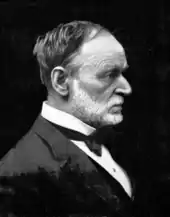
Sherman lived most of the rest of his life in New York City. He was devoted to the theater and to amateur painting and was in demand as a colorful speaker at dinners and banquets, in which he indulged a fondness for quoting Shakespeare.[10][258] During this period, he remained in contact with war veterans, and he was an active member of various social and charitable organizations.[259]
Proposed as a Republican candidate for the presidential election of 1884, Sherman declined as emphatically as possible, saying, "I will not accept if nominated and will not serve if elected."[260] Such a categorical rejection of a candidacy is now referred to as a "Shermanesque statement".[261]
In 1886, after the publication of Grant's memoirs, Sherman produced a "second edition, revised and corrected" of his own memoirs. The new edition, published by Appleton, added a second preface, a chapter about his life up to 1846, a chapter concerning the post-war period (ending with his 1884 retirement from the army), several appendices, portraits, improved maps, and an index. For the most part, Sherman refused to revise his original text on the ground that "I disclaim the character of historian, but assume to be a witness on the stand before the great tribunal of history" and "any witness who may disagree with me should publish his own version of [the] facts in the truthful narration of which he is interested".[262] However, Sherman did add the appendices, in which he published the views of some others.[lower-alpha 12][lower-alpha 13]
Death

Sherman died of pneumonia in New York City at 1:50 PM on February 14, 1891, six days after his 71st birthday.[266] President Benjamin Harrison, who served under Sherman, sent a telegram to Sherman's family and ordered all national flags to be flown at half staff. Harrison, in a message to the Senate and the House of Representatives, wrote that:
He was an ideal soldier, and shared to the fullest the esprit de corps of the army, but he cherished the civil institutions organized under the Constitution, and was only a soldier that these might be perpetuated in undiminished usefulness and honor.[267]
On February 19, a funeral service was held at his home, followed by a military procession. Joseph E. Johnston, the Confederate officer who had commanded the resistance to Sherman's troops in Georgia and the Carolinas, served as a pallbearer in New York City. It was a bitterly cold day and a friend of Johnston, fearing that the general might become ill, asked him to put on his hat. Johnston replied: "If I were in [Sherman's] place, and he were standing in mine, he would not put on his hat." Johnston did catch a serious cold and died one month later of pneumonia.[268][269]
Sherman's body was then transported to St. Louis, where another service was conducted at a local Catholic church on February 21, 1891. His son, Thomas Ewing Sherman, who was a Jesuit priest, presided over his father's funeral masses in New York City and in St. Louis.[270] Former U.S. president and Civil War veteran Rutherford B. Hayes, who attended both ceremonies, said at the time that Sherman had been "the most interesting and original character in the world."[271] He is buried in Calvary Cemetery in St. Louis.[272]
Religious views
Sherman's birth family was Presbyterian and he was originally baptized as such. His foster mother, Maria Ewing, was devoutly Catholic and raised her own children in that faith. Sherman was re-baptized in the Catholic rite, but Maria's husband, Senator Thomas Ewing, insisted that the young Sherman not be compelled to practice Catholicism. Sherman observed but did not join in the religious ceremonies of the Ewing household.[273] He later married his foster sister Ellen, who was also a devout Catholic. In 1864, she took up temporary residence in South Bend, Indiana, to have her young family educated at the University of Notre Dame and St. Mary's College, both of them Catholic institutions.[274] Sherman wrote to his wife in 1842: "I believe in good works rather than faith."[275]
Some modern historians have characterized Sherman as a deist in the manner of Thomas Jefferson,[276] while others identify him as an agnostic who accepted many Christian values but lacked faith.[277] In his letters to Thomas, his eldest surviving son, Sherman said "I dont [sic] want you to be a soldier or a priest, but a good useful man",[278] and complained that Thomas's mother Ellen "thinks religion is so important that everything else must give way to it".[279] Thomas's decision to abandon his career as a lawyer in 1878 to join the Jesuits and prepare for the Catholic priesthood caused Sherman profound distress, and he referred to it as a "great calamity". Father and son, however, were reconciled when Thomas returned to the United States in August 1880, after having travelled to England for his religious instruction.[280]
Except during the personal crisis triggered by Thomas's decision to become a priest, Sherman's personal attitude towards the Catholic Church was tolerant and even friendly at a time when anti-Catholic prejudice was common in the United States.[281] In 1888, Sherman wrote publicly that "my immediate family are strongly Catholic. I am not and cannot be."[282] Upon Sherman's death, his son Thomas reportedly said: "My father was baptized in the Catholic Church, married in the Catholic Church, and attended the Catholic Church until the outbreak of the civil war. Since that time he has not been a communicant of any church."[283][284]
Monuments and tributes
The gilded bronze Sherman Memorial (1902) by Augustus Saint-Gaudens stands at the Grand Army Plaza near the main entrance to New York City's Central Park.[285] Sherman is represented astride his horse Ontario and led by a winged female figure of Victory.[285] Saint-Gaudens's Bust of William Tecumseh Sherman, which he used as the basis for the larger Memorial, is at the Metropolitan Museum of Art.[286] Arlington National Cemetery features a smaller version of Saint-Gaudens's statue of Victory.[287]
The General William Tecumseh Sherman Monument (1903) by Carl Rohl-Smith[288] stands near President's Park in Washington, D.C.[289] The bronze monument consists of an equestrian statue of Sherman and a platform with a soldier at each corner, representing the infantry, artillery, cavalry, and engineer branches of the U.S. Army. The site was chosen because Sherman was reported to have stood there while reviewing returning Civil War troops in May 1865.[289]
Other posthumous tributes include Sherman Circle in the Petworth neighborhood of Washington, D.C.,[290] the M4 Sherman tank, which was named by the British during World War II,[291] and the "General Sherman" Giant Sequoia tree, which is the most massive documented single-trunk tree in the world.[292]
Historical reputation
In the years immediately after the war, Sherman was popular in the North and well regarded by his own soldiers.[293] At the same time, he was generally respected in the South as a military man, while his conservative politics were attractive to many white Southerners.[294] By the 1880s, however, Southern "Lost Cause" writers began to demonize Sherman for his attacks on civilians in Georgia and South Carolina. The magazine Confederate Veteran, based in Nashville, dedicated more attention to Sherman than to any other Union general, in part to enhance the visibility of the Civil War's Western Theater.[295] In this new discourse, Sherman's devastation of railroads and plantations mattered less than his insults to southern dignity and especially to its unprotected womanhood.[296] Sherman was thus represented by "Lost Cause" writers as the antithesis of the Southern ideals of chivalry supposedly embodied by Lee.[297]
In the early 20th century, Sherman's role in the Civil War attracted attention from influential British military intellectuals, including Field Marshal Lord Wolseley, Maj. Gen. J. F. C. Fuller, and especially Capt. Liddell Hart. American historian Wesley Moody has argued that these commentators tended to filter Sherman's actions and his hard-war strategy through their own ideas about modern warfare, thereby contributing to the exaggeration of his "atrocities" and unintentionally feeding into the negative assessment of Sherman's moral character associated with the "Lost Cause" school of Southern historiography.[298] This led to the publication of several works, notably John B. Walters's Merchant of Terror: General Sherman and Total War (1973),[299] which presented Sherman as responsible for "a mode of warfare which transgressed all ethical rules and showed an utter disregard for human rights and dignity."[300] Following Walters, James Reston Jr. argued in 1984 that Sherman had planted the "seed for the Agent Orange and Agent Blue programs of food deprivation in Vietnam".[301] More recently, historians such as Holden-Reid have challenged such readings of Sherman's record and of his contributions to modern warfare.[302]
Dates of rank
| Insignia | Rank | Date | Component |
|---|---|---|---|
| No insignia | Cadet, USMA | July 1, 1836 | Regular Army |
| Second Lieutenant | July 1, 1840 | Regular Army | |
| First Lieutenant | November 30, 1841 | Regular Army | |
| Brevet Captain | May 30, 1848 | Regular Army | |
| Captain | September 27, 1850 | Regular Army (Resigned September 6, 1853.) | |
| Colonel | May 14, 1861 | Regular Army | |
| Brigadier General | May 17, 1861 | Volunteers | |
| Major General | May 1, 1862 | Volunteers | |
| Brigadier General | July 4, 1863 | Regular Army | |
| Major General | August 12, 1864 | Regular Army | |
| Lieutenant General | July 25, 1866 | Regular Army | |
| General | March 4, 1869 | Regular Army | |
| General | February 8, 1884 | Retired | |
| Source: [303] | |||
Publications
- Personal memoirs of Gen. W.T. Sherman. Vol. 1 (3 ed.). Charles L. Webster & Co. 1890.
- Personal memoirs of Gen. W.T. Sherman. Vol. 2 (3 ed.). Charles L. Webster & Co. 1890.
See also
- List of American Civil War generals (Union)
Notes
- One 19th-century source, for example, states that "General Sherman, we believe, is the only eminent American named from an Indian chief". Howe's Historical Collections of Ohio (Columbus, 1890), I: 595.
- See, e.g., the many letters reproduced in Brooks D. Simpson and Jean V. Berlin, Sherman's Civil War: Selected Correspondence of William T. Sherman (Chapel Hill: Univ. of North Carolina Press, 1999).
- For further details about Sherman's banking career, see Dwight L. Clarke, William Tecumseh Sherman: Gold Rush Banker (San Francisco: California Historical Society, 1969).
- For more detailed discussion of this overall period, see Marszalek, Sherman, pp. 154–167; Hirshson, White Tecumseh, pp. 95–105; Kennett, Sherman, pp. 127–149.
- The nomination was not submitted to the Senate until December.[124]
- This message was put on a vessel on December 22, passed on by telegram from Fort Monroe, Virginia, and apparently received by Lincoln on Christmas Day itself.[137] See also Official Records, Series I, vol. 44, 783; New York Times, December 26, 1864 Archived February 16, 2017, at the Wayback Machine
- Liddell Hart's claims for his own influence on the German doctrine of Blitzkrieg and on the German use of tanks in World War II, as well as his relations with leaders of the Wehrmacht after the war's end, have attracted criticism and controversy. See, e.g., "Hart, Sir Basil Henry Liddell". Oxford Dictionary of National Biography (online ed.). Oxford University Press. doi:10.1093/ref:odnb/33737. (Subscription or UK public library membership required.).
- Sherman wrote in a letter to Halleck, dated December 24, 1864, "that we are not only fighting hostile armies, but a hostile people, and must make old and young, rich and poor, feel the hard hand of war, as well as their organized armies."[195]
- According to Victor Davis Hanson, "In the eyes of Lewis and Liddell Hart, Sherman was a great man, who is judged on what he did and not on what he wrote: he saved lives and shortened the war; and he used military science to teach his nation what war is ultimately for."[222]
- This letter was to James E. Yeatman, May 21, 1865, and is excerpted more extensively (and with slight variations) in Bowman and Irwin.[224]
- In 1875, Henry V. Boynton published a critical review of Sherman's memoirs "based upon compilations from the records of the war office".[248] A defense of Sherman by C. W. Moulton was also published that year.[249]
- In one amusing change to his text, Sherman dropped the assertion that John Sutter, of gold-rush fame, had become "very 'tight'" at a Fourth of July celebration in 1848 and stated instead that Sutter "was enthusiastic".[263][264]
- A "third edition, revised and corrected" of Sherman's memoirs was put out in 1890 by Mark Twain's firm Charles L. Webster & Co., which had published Grant's memoirs. This and other later versions were all printed from the plates of the 1886 or, in some cases, the 1875 edition.[265]
References
- Lewis 1993, p. i.
- "William T. Sherman Family papers". University of Notre Dame Archives. University of Notre Dame. Retrieved January 2, 2022.
- Official Army Register for January, 1885. Washington, D.C.: Adjutant General's Office. 1885. p. 265.
- "Tecumseh". Dictionary.com Unabridged (Online). n.d.
- "Tecumseh". The American Heritage Dictionary of the English Language (5th ed.). HarperCollins.
- Woodworth 2005, p. 631: "[Sherman's] genius [for] strategy and logistics ... made him one of the foremost architects of Union victory"
- Liddell Hart 1993, p. 430.
- Ricks, Thomas E. (June 15, 2016). "'William Tecumseh Sherman,' by James Lee McDonough". The New York Times. Retrieved February 5, 2022.
- Dobbs, David. "Madness, Genius, & Sherman's Ruthless March". Wired. ISSN 1059-1028. Retrieved December 30, 2021.
- Woodward 1990.
- Marszalek 2007, p. 4.
- Holden-Reid 2020, p. 21.
- Marszalek 2007, p. 1.
- McDonough 2016, pp. 148–149.
- Sherman 1890a, p. 11.
- Lewis 1993, p. 23.
- Marszalek 2007, pp. xiv–xv n.1.
- Schenker 2008, p. 55.
- Holden-Reid 2020, p. 19.
- Lewis 1993, p. 34.
- Walsh 2005, p. 32.
- Holden-Reid 2020, p. 24.
- Holden-Reid 2020, p. 30.
- Hirshson 1997, p. 13.
- Sherman 1890a, p. 17.
- Sherman 1890a, p. 26.
- Hirshson 1997, p. 21.
- Holden-Reid 2020, p. 43.
- O'Connell 2014, p. 29.
- Sherman 1890a, pp. 42–43.
- O'Connell 2014, pp. 29–30.
- "William Tecumseh Sherman (1820–1891)". Museum of the City of San Francisco. Archived from the original on May 9, 2007. Retrieved December 26, 2021.
- WPA Writers' Program of the Work Projects Administration in Southern California (1941). "Monterey Peninsula". J.L. Delkin: 9, 86. Retrieved August 12, 2022.
- "Sherman and the Discovery of Gold". Museum of the City of San Francisco. Archived from the original on February 9, 2006. Retrieved December 26, 2021.
- O'Connell 2014, p. 35.
- Holden-Reid 2020, p. 46.
- O'Connell 2014, pp. 35–36.
- "Survey Report: Raised Streets & Hollow Sidewalks, Sacramento, California" (PDF). City of Sacramento. July 20, 2009. p. 7. Retrieved August 9, 2021.
{{cite web}}: CS1 maint: url-status (link) - Holden-Reid 2020, pp. 46–47.
- Dougherty 2007, pp. 96–100.
- Burton 1947, pp. 72–78.
- Kennett 2001, pp. 34, 72.
- "Family Trees of the Interconnected Sherman and Ewing Families". Library of Congress. Retrieved November 30, 2021.
- Holden-Reid 2020, pp. 52–53.
- Holden-Reid 2020, pp. 55–56.
- Sherman 1890a, p. 160–161.
- Royster 1991, pp. 133–134.
- Holden-Reid 2020, pp. 56–57.
- Sherman 1890a, pp. 140–144.
- Sherman 1990, Chronology, p. 1093.
- Holden-Reid 2020, pp. 61–62.
- Holden-Reid 2020, pp. 62–63.
- "Department of Military Science: Unit History". Army ROTC. Louisiana State University. Archived from the original on March 13, 2016. Retrieved December 26, 2021.
- Holden-Reid 2020, pp. 63–64.
- Holden-Reid 2020, pp. 63, 67–68.
- Hirshson 1997, p. 68.
- Walters 1973, p. 9.
- Lewis 1993, p. 138.
- Lewis 1993, p. 138; Exchange between W. T. Sherman and Prof. David F. Boyd, December 24, 1860, attributed to "Boyd (D.F), mss. [manuscripts] in possession of Walter L. Fleming, Nashville, Tenn.".
- Sherman 1890a, letter by Sherman to Gov. Thomas O. Moore, January 18, 1861, reproduced in pp. 183–184.
- Marszalek 2007, pp. 140–141.
- Sherman 1890a, pp. 194–196.
- Marszalek 2007, pp. 141–144.
- Holden-Reid 2020, pp. 81–82.
- Holden-Reid 2020, p. 79.
- Sherman 1890a, pp. 197–199.
- Bowman & Irwin 1865, p. 25.
- Hirshson 1997, pp. 83–86.
- Simpson & Berlin 1999, Sherman to Thomas Ewing Jr., June 3, 1861, in pp. 97–98..
- Holden-Reid 2020, pp. 86–87.
- "Union Order of Battle – First Manassas". National Park Service. November 21, 2021. Retrieved December 9, 2021.
- Miller 2019, p. 67.
- Holden-Reid 2020, p. 96.
- Holden-Reid 2020, p. 97.
- Hirshson 1997, pp. 90–94, 109.
- Sherman 1890a, pp. 221, 227.
- Sears 1989, Sherman to George B. McClellan, November 4, 1861, in p. 127, note 1.
- Marszalek 2007, pp. 161–164.
- Lewis 1993, p. 203.
- Simpson & Berlin 1999, Sherman to John Sherman, January 4, 8, 1862, in pp. 174, 176.
- Marszalek 2007, pp. 162, 164.
- Kennett 2001, pp. 155–156.
- Sherman to Grant, February 15, 1862, Papers of Ulysses S. Grant 4:216n
- Smith 2001, pp. 151–152.
- Eicher & Eicher 2001, p. 485.
- Daniel 1997, p. 138.
- Walsh 2005, Quoted in pp. 77–78.
- Smith 2001, p. 212.
- Schenker 2010, p. 215.
- Marszalek 2007, pp. 188–201.
- Marszalek 2007, pp. 199–200..
- Holden-Reid 2020, pp. 153–155.
- Winters 1963, p. 176.
- Marszalek 2007, pp. 202–208.
- Smith 2001, p. 224.
- Smith 2001, p. 227.
- Marszalek 2007, pp. 208–210.
- Sherman 1890a, pp. 324–331.
- Holden-Reid 2020, p. 169.
- Smith 2001, pp. 235–236.
- Daniel 1997, pp. 309–310.
- Gabel 2013, p. 26.
- Reid 1868, p. 387.
- Kennedy 1998, p. 173.
- Holden-Reid 2020, p. 205.
- Holden-Reid 2020, p. 206.
- Holden-Reid 2020, p. 207.
- Sherman 1890a, pp. 372–377.
- Holden-Reid 2020, p. 218.
- Holden-Reid 2020, p. 220.
- McPherson 2003, pp. 677–680.
- Foster 2006, pp. 14–32.
- Sherman 1890a, pp. 415–433.
- Holden-Reid 2020, p. 243.
- Holden-Reid 2020, p. 244.
- Holden-Reid 2020, p. 252.
- Holden-Reid 2020, pp. 250–253.
- Sherman 1890b, p. 116.
- McPherson 2003, p. 653.
- Holden-Reid 2020, p. 495.
- Marszalek 2007, pp. 276–279.
- O'Connell 2014, pp. 144–146.
- Sherman 1890b, p. 102.
- Eicher & Eicher 2001, p. 702.
- Bonds 2009, pp. 337–374.
- McPherson 2008, pp. 231–250.
- Holden-Reid 2020, p. 330.
- Simpson & Berlin 1999, Telegram W.T. Sherman to Gen. Ulysses S. Grant, October 9, 1864, reproduced in p. 731.
- Senour 1865, p. 293.
- Hirshson 1997, pp. 246–247, 431 n. 23.
- Simpson & Berlin 1999, W.T. Sherman to Gen. U.S. Grant, November 1, 1864, reproduced in pp. 746–747.
- Trudeau 2008, p. 76.
- Grimsley 1997, Report by Maj. Gen. W.T. Sherman, January 1, 1865, quoted in p. 200.
- Marszalek 2007, p. 308.
- Granger, Arthur O. "15th Regiment Cavalry Pennsylvania Volunteers: The Fifteenth at General Joe Johnston's Surrender". Pennsylvania Roots. Retrieved June 6, 2022.; Smith, Tony. "Overlook Scope". Lowndes County Historical Society Museum. Valdosta, Georgia. Retrieved June 5, 2022.
- Holden-Reid 2020, p. 371.
- Sherman 1890b, pp. 231–232.
- See, for instance, Liddell Hart, p. 354.
- Brockett 1866, p. 175 (p. 162 in 1865 edition).
- Marszalek 2007, p. 311.
- Marszalek 2008, pp. 5, 17–18.
- Marszalek 2007, pp. 320–321.
- McPherson 2003, Johnston in quoted in p. 828.
- Marszalek 2007, pp. 322–325.
- Lewis 1993, p. 513.
- Marszalek 2007, p. 327.
- Holden-Reid 2020, p. 394.
- Marszalek 2007, pp. 334–335.
- Pfanz 1989, pp. 1–2, 24–29, 94–95.
- Sherman 1890b, pp. 322–331.
- "The Peacemakers". The White House Historical Association. Archived from the original on September 27, 2011. Retrieved December 26, 2021.
- Marszalek 2007, p. 339.
- Holden-Reid 2020, pp. 403–404.
- Holden-Reid 2020, p. 404.
- Holden-Reid 2020, p. 405.
- Holden-Reid 2020, pp. 414–415.
- "Bennett Place Surrender". American Battlefield Trust. October 23, 2018. Retrieved January 7, 2022.
The surrender at Bennett Place was the largest surrender of the entire war, which included approximately 90,000 Confederates stationed in North Carolina, South Carolina, Georgia and Florida.
- Kennett 2001, p. 287.
- Simpson & Berlin 1999, Letter to Salmon P. Chase, January 11, 1865, in pp. 794–795.
- Liddell Hart 1993, Letter by W.T. Sherman to John Sherman, August 1865 p. 406.
- Marszalek 2007, pp. 46, 124, 142.
- Brands 2012, pp. 106–107.
- Bassett, Thom (January 17, 2012). "Sherman's Southern Sympathies". The New York Times. Archived from the original on February 6, 2012. Retrieved February 5, 2012.
- Sherman 1890a, pp. 176–178.
- O'Connell 2014, p. xvi.
- Holden-Reid 2020, p. 372.
- Sherman 1890b, p. 248.
- Sherman 1890b, p. 249.
- Foner 2006, p. 3.
- McPherson 2003, p. 841.
- Marszalek 2007, p. 314.
- Foner 2006, pp. 3–6.
- Sherman 1890b, pp. 244–247.
- Foner 2006, p. 5.
- "Minutes of an interview between the colored ministers and church officers at Savannah with the Secretary of War and Major-Gen. Sherman". Freedmen and Southern Society Project. University of Maryland. Retrieved December 17, 2021.
- "Order by the Commander of the Military Division of the Mississippi: Special Field Orders, No. 15". Freedmen and Southern Society Project. University of Maryland. January 16, 1865. Retrieved December 25, 2021.
- McPherson 2003, pp. 737–739.
- Myers, Barton. "Sherman's Field Order No. 15". New Georgia Encyclopedia. Georgia Humanities. Retrieved September 18, 2021.
- O'Connell 2014, pp. xvi–xvii.
- Holden-Reid 2020, p. 8.
- Sherman 1888a.
- O'Connell 2014, p. 324.
- Holden-Reid 2020, pp. 8, 505–507.
- Dickey 2018, Quoted in p. 386.
- Luvaas 1993, pp. vii–x.
- Hanson 2001, pp. 253–254, 257, 408.
- Holden-Reid 2020, pp. 492–493.
- Liddell Hart 1993, pp. 231–252.
- Liddell Hart 1957, pp. xiii–xvi.
- Wilson 1994, p. 179.
- Hanson 2001, pp. 283–284.
- Hirshson 1997, p. 393, quoting B. H. Liddell Hart, "Notes on Two Discussions with Patton, 1944", February 20, 1948, GSP Papers, box 6, USMA Library.
- Grimsley 1997, pp. 4–5.
- Murray, Jennifer (December 7, 2020). "Hard War in Virginia during the Civil War". Encyclopedia Virginia. Virginia Humanities. Retrieved January 4, 2022.
- Sherman 1890b, quoted in p. 227.
- Holden-Reid 2020, p. 500.
- Grimsley 1997, pp. 190–204.
- McPherson 2003, pp. 712–714, 727–729.
- Grimsley 1997, p. 199.
- McPherson 2003, pp. 810–811.
- Hitchcock 1995, p. 125.
- Holden-Reid 2020, p. 326.
- O'Connell 2014, pp. 242–243.
- Grimsley 1997, pp. 200–202.
- Scott 1884, p. 185.
- Wade Hampton et al., The Burning of Columbia (Charleston, SC: Walker, Evans & Cogswell Co., 1888), p. 11
- Lucas 2000, December 11, 1872, deposition, Mixed Commission, XIV, 91, quoted in p. 154.
- Sherman 1890b, p. 287.
- McPherson 2003, pp. 728–729.
- Woodworth 2005, p. 636.
- Sherman 1890b, pp. 350–351.
- Marszalek 2007, p. 285.
- Holden-Reid 2020, pp. 332–333.
- Sherman, W.T. (September 12, 1864). "James M. Calhoun, Mayor, E. E. Pawson and S. C. Wells, representing City Council of Atlanta". General William T. Sherman on War. Academic American History. Archived from the original on October 11, 2011.
- Wilson 1994, p. 184.
- McNamara & Blight 2001, p. 130.
- Giliomee 2003, p. 253.
- Liddell Hart 1993, pp. 428–431.
- Hanson 2001, pp. 227–231.
- Marszalek 2007, p. 499.
- Holden-Reid 2020, pp. 501–504.
- Hanson 2001, p. 439.
- Liddell Hart 1993, Quoted in p. 402.
- Bowman & Irwin 1865, pp. 486–488.
- Athearn 1956, pp. 33–44.
- Smith 2001, p. 434.
- Athearn 1956, pp. 196–197.
- Athearn 1956, p. 203.
- Extracts from the Journal of the United States Senate In All Cases of Impeachment Presented By The United States House of Representatives (1798-1904). Congressional serial set. Washington Government Printing Office. 1912. pp. 254 and 261.
- Hansen, John Mark (November 21, 2021). "The complicated history of Gen. Philip Sheridan". Chicago Tribune. Retrieved December 17, 2021.
- Hamilton, Allen Lee. "Warren Wagontrain Raid". Texas State Historical Association. Retrieved November 30, 2021.
- Athearn 1956, Sherman to Rawlins, October 23, 1865, as quoted on p. 24.
- Athearn 1956, p. 24.
- Sherman to Grant, December 28, 1866, Papers of Ulysses S. Grant 16:422
- Sherman to Grant, May 28, 1867, quoted in Fellman, Citizen Sherman, pp. 264, 453 n5. See also Papers of Ulysses S. Grant, 17:262.
- Marszalek 2007, quoted on p. 379.
- Fernández-Armesto, Felipe (2014). Our America: A Hispanic History of the United States. New York: W. W. Norton & Company. p. 178.
- Ingham, Donna (2010). Mysteries and Legends of Texas: True Stories of the Unsolved and Unexplained. Rowman & Littlefield. p. 35.
- O'Connell 2014, pp. 203–204.
- "William T. Sherman". National Portrait Gallery Collection. Smithsonian Institution. Retrieved January 7, 2022.
- Holden-Reid 2020, pp. 440–441.
- Athearn 1956, pp. 268–269.
- Lewis 1993, see, for instance, pp. 597–600.
- Marszalek 2007, p. 564 n4.
- Athearn 1956, p. 291.
- Marszalek 2007, p. 461.
- Marszalek 2007, p. 463.
- Boynton, Henry V. (1875). Sherman's historical raid. The Memoirs in the light of the record. A review based upon compilations from the files of the War Office. Cincinnati, Wilstach, Baldwin & Co.
- Moulton, C.W. (1875). The review of General Sherman's Memoirs examined, chiefly in the light of its own evidence. Cincinnati, R. Clarke & co., printers.
A criticism of H. V. Boynton's 'Sherman's historical raid. The Memoirs in the light of the record', Cincinnati, 1875.
- Extract from John Russell Young, Around the World with General Grant, vol. II, 290–91, quoted in Sherman, Memoirs (Library of America ed., 1990), p. 1054.
- Wilson 1994, p. 175.
- Brands 2012, p. 570.
- Shapiro, Fred R.; Epstein, Joseph, eds. (2006). The Yale Book of Quotations. Yale University Press. p. 708. ISBN 978-0-30010-798-2.
- Lewis 1993, Reproduced on p. 637 from transcript published in the Ohio State Journal, August 12, 1880..
- Warner 1964, p. 443.
- "Timeline: A Chronology of Key Events in the Life of William T. Sherman, 1820–1891". Collection: William T. Sherman Papers. Library of Congress. Retrieved December 23, 2021.
- Cutrer, Thomas W. "Sherman, William Tecumseh (1820–1891)". Texas State Historical Association. Retrieved September 11, 2021.
- Marszalek 2007, pp. 480, 482–483, 490.
- Marszalek 2007, pp. 479–480.
- Marszalek 2000, p. 1769.
- Hansen, Liane; Schorr, Daniel (June 24, 2007). "Not Running? Say So, Sherman Style". NPR. Retrieved November 20, 2021.
- Sherman 1990, Preface to the Second Edition, p. 5.
- Sherman 1990, Note on the Text, p. 1123.
- H.W. Brands, The Age of Gold (Doubleday, 2002), p. 271.
- Sherman 1990, Note on the Text, p. 1122.
- Holden-Reid 2020, p. 489.
- February 15, 1891 New York Times article, quoting Harrison message of February 14: "Sorrow at the Capital: Formal Announcement by the President – Eulogies in the Senate" (PDF). The New York Times. February 15, 1891. Retrieved December 25, 2021.
- Lewis 1993, See, for instance, p. 652.
- Marszalek 2007, pp. 495–498.
- Marszalek 2007, pp. 491–499.
- Holden-Reid 2020, as quoted on p. 409.
- Warner 1964, p. 444.
- Detzler 1966, p. 28.
- Sorin 1992, p. 289.
- Howe 1909, pp. 17–20, W. T. Sherman to Ellen Ewing, April 7, 1842.
- Gannon 1996, pp. 307–308.
- Holden-Reid 2020, pp. 40–41, 470.
- "In Headquarters, Military Division of the Mississippi In the Field, Savannah, Geo.: Dear Tommy". Sherman Letters. University of Notre Dame. January 21, 1865. Retrieved December 23, 2021.
- Hirshson 1997, Quoted in p. 349.
- Holden-Reid 2020, pp. 481–482.
- Detzler 1966, p. 31.
- Sherman 1888b, p. 624.
- Fletcher 1891, p. 139.
- Hirshson 1997, pp. 387–388.
- "William Tecumseh Sherman". Central Park Conservancy. Retrieved December 25, 2021.
- "General William Tecumseh Sherman 1888, cast 1910". The Metropolitan Museum of Art. Retrieved December 25, 2021.
- "The sculpture "Victory" fully restored, on display at the Memorial Amphitheater" (Press release). Arlington National Cemetery. April 25, 2017. Retrieved December 25, 2021.
- "Gen. Sherman Monument" (PDF). The New York Times. May 28, 1896. p. 3. Retrieved December 25, 2021.
- "General William Tecumseh Sherman Statue". National Park Service. Retrieved December 25, 2021.
 This article incorporates text from this source, which is in the public domain.
This article incorporates text from this source, which is in the public domain. - Fortier 2014, p. 148.
- Estéve 2020, pp. 8–9.
- Paúl, María Luisa (December 25, 2021). "Firefighters are girding Earth's biggest tree. Here's how General Sherman got its name(s)". The Washington Post. Retrieved September 19, 2021.
- Caudill & Ashdown 2008, p. 5.
- Moody 2011, p. 105.
- Moody 2011, p. 108.
- Moody 2011, p. 110.
- Holden-Reid 2020, pp. 386–387, 499.
- Moody 2011, pp. 132–142.
- Moody 2011, p. 145.
- Walters 1973, p. 82.
- Holden-Reid 2020, as quoted on p. 500.
- Holden-Reid 2020, see example on pp. 499–507.
- Heitman, Francis B. (1903). Historical Register and Dictionary of the United States Army. Vol. 1. U.S. Government Printing Office. p. 882.
Works cited
- Athearn, Robert G. (1956). William Tecumseh Sherman and the Settlement of the West. University of Oklahoma Press. ISBN 978-0-80612-769-9.
- Bonds, Russell S. (2009). War Like the Thunderbolt: The Battle and Burning of Atlanta. Westholme Publishing. ISBN 978-1-59416-100-1.
- Bowman, Samuel M.; Irwin, Richard B. (1865). Sherman and His Campaigns. Charles B. Richardson.
- Brands, H.W. (2012). The Man Who Saved the Union: Ulysses S. Grant In War and Peace. Anchor. ISBN 978-0-30747-515-2.
- Brockett, L.P. (1866). Our Great Captains: Grant, Sherman, Thomas, Sheridan, and Farragut. Charles B. Richardson.
- Burton, Katherine (1947). Three Generations: Maria Boyle Ewing – Ellen Ewing Sherman – Minnie Sherman Fitch. Longmans, Green & Co.
- Caudill, Edward; Ashdown, Paul (2008). Sherman's March in Myth and Memory. Rowman & Littlefield Publishers. ISBN 978-0-74255-027-8.
- Daniel, Larry J. (1997). Shiloh: The Battle That Changed the Civil War. Simon & Schuster. ISBN 978-0-68480-375-3.
- Detzler, Jack J (1966). "The Religion of William Tecumseh Sherman". Ohio History Journal. 75 (1): 26–34.
- Dickey, J. D. (2018). Rising in Flames: Sherman's March and the Fight for a New Nation. Pegasus Books. ISBN 978-1-68177-757-3.
- Dougherty, Kevin (2007). Civil War Leadership and Mexican War Experience. University of Mississippi Press. ISBN 978-1-57806-968-2.
- Eicher, John H.; Eicher, David J. (2001). Civil War High Commands. Stanford University Press. ISBN 978-0-80473-641-1.
- Estéve, Michel (2020). Sherman: The M4 Tank in World War II. Casemate. ISBN 978-1-61200-740-3.
- Fletcher, Thomas C. (1891). Life and Reminiscences of General Wm. T. Sherman by Distinguished Men of His Time. Baltimore, Maryland: R. H. Woodward Co.
- Foner, Eric (2006). Forever Free: The Story of Emancipation and Reconstruction. Vintage. ISBN 978-0-3757-0274-7.
- Fortier, Alsion (2014). A History Lover's Guide to Washington, D.C. Arcadia Publishing. ISBN 978-1-62585-064-5.
- Foster, Buck T. (2006). Sherman's Meridian Campaign. University of Alabama Press. ISBN 978-0-81731-519-1.
- Gabel, Christopher R. (2013). The Vicksburg Campaign: November 1862 – July 1863 (PDF). Center for Military History.
- Gannon, B. Anthony (1996). "A Consistent Deist: Sherman and Religion". Civil War History. 42 (4): 307–321. doi:10.1353/cwh.1996.0023.
- Giliomee, Hermann (2003). The Afrikaners: Biography of a People. University Press of Virginia. ISBN 978-0-81392-237-9.
- Grimsley, Mark (1997). The Hard Hand of War: Union Military Policy toward Southern Civilians, 1861–1865. Cambridge University Press. ISBN 978-0-52159-941-2.
- Hanson, Victor Davis (2001). The Soul of Battle. Anchor. ISBN 9-780-38572-059-5. OCLC 793155253.
- Hirshson, Stanley P. (1997). The White Tecumseh: A Biography of General William T. Sherman. John Wiley & Sons. ISBN 978-0-47128-329-4.
- Hitchcock, Henry (1995) [1927]. Howe, M. A. DeWolfe (ed.). Marching with Sherman: Passages from the Letters and Campaign Diaries of Henry Hitchcock, Major and Assistant Adjutant General of Volunteers, November 1864 – May 1865. University of Nebraska Press. ISBN 978-0-80327-276-7.
- Holden-Reid, Brian (2020). The Scourge of War: The Life of William Tecumseh Sherman. Oxford University Press. ISBN 978-0-19539-273-9. See book review at Bordewich, Fergus M. (May 29, 2020). "'The Scourge of War' Review: A Long March Into Myth". The Wall Street Journal. Retrieved January 7, 2022.
- Howe, M.A. DeWolfe, ed. (1909). Home Letters of General Sherman. Charles Scribner's Sons. OCLC 771807920.
- Kennedy, Frances H., ed. (1998). The Civil War Battlefield Guide (2nd ed.). Boston & New York: Houghton Mifflin. ISBN 978-0-395-74012-5.
- Kennett, Lee (2001). Sherman: A Soldier's Life. HarperCollins. ISBN 978-0-06-017495-8.
- Lewis, Lloyd (1993) [1932]. Sherman: Fighting Prophet. University of Nebraska Press. ISBN 978-0-80327-945-2.
- Liddell Hart, B. H. (1957). "Foreword to New Edition". The Memoirs of General William T. Sherman by Himself. By Sherman, William T. Indiana University Press.
- Liddell Hart, B. H. (1993) [1929]. Sherman: Soldier, Realist, American. Da Capo Press. ISBN 978-0-30680-507-3.
- Lucas, Marion B. (2000). Sherman and the Burning of Columbia. University of South Carolina Press. ISBN 978-1-64336-246-5.
- Luvaas, Jay (1993). "Introduction: Sherman and the 'Indirect Approach'". Sherman: Soldier, Realist, American. By Liddell Hart, B. H. Da Capo Press. ISBN 978-0-30680-507-3.
- Marszalek, John F. (2007) [1992]. Sherman: A Soldier's Passion for Order (Reissued with new preface ed.). Southern Illinois University Press. ISBN 978-0-02-920135-0.
- Marszalek, John F. (2000). "William Tecumseh Sherman". In Heidler, David S.; Heidler, Jeanna T. (eds.). Encyclopedia of the American Civil War: A Political, Social, and Military History. W. W. Norton & Company. ISBN 978-0-39304-758-5.
- Marszalek, John F. (2008). "'Take the Seat of Honor': William T. Sherman". In Woodworth, Steven E. (ed.). Grant's Lieutenants: From Chattanooga to Appomattox. Lawrence, Kansas: University Press of Kansas. ISBN 978-0-70061-589-6.
- McDonough, James Lee (2016). William Tecumseh Sherman: In the Service of My Country: A Life. W. W. Norton. ISBN 978-0-39324-157-0.
- McNamara, Robert S.; Blight, James G. (2001). Wilson's Ghost: Reducing the Risk of Conflict, Killing, and Catastrophe in the 21st Century. Public Affairs. ISBN 978-1-89162-089-8.
- McPherson, James M. (2003). Battle Cry of Freedom: The Civil War Era. Oxford University Press. ISBN 978-0-19-515901-1.
- McPherson, James M. (2008). Tried by War: Abraham Lincoln as Commander in Chief. New York: Penguin Books. pp. 231–250. ISBN 978-0-14311-614-1.
- Miller, Donald L. (2019). Vicksburg: Grant's Campaign that Broke the Confederacy. New York, New York: Simon and Schuster. ISBN 978-1-45164-139-4.
- Moody, Wesley (2011). Demon of the Lost Cause: Sherman and Civil War History. University of Missouri Press. ISBN 978-0-82621-945-9.
- O'Connell, Robert L. (2014). Fierce Patriot: The Tangled Lives of William Tecumseh Sherman. Random House. ISBN 978-1-40006-972-9. See book review at Rollyson, Carl (June 17, 2016). "The Magnitude of His Achievement". The Wall Street Journal. Retrieved December 24, 2021.
- Pfanz, Donald C. (1989). The Petersburg Campaign: Abraham Lincoln at City Point. Lynchburg, Virginia: H. E. Howard. ISBN 978-0-93091-976-4.
- Reid, Whitelaw (1868). Ohio in the War: Her Statesmen, Her Generals, and Soldiers. Vol. 1. New York: Moore, Wilstach & Baldwin.
- Royster, Charles (1991). The Destructive War: William Tecumseh Sherman, Stonewall Jackson, and the Americans. Alfred A. Knopf. ISBN 978-0-67973-878-7.
- Schenker, Carl R. Jr. (January 2008). "'My Father...Named Me William Tecumseh': Rebutting the Charge That General Sherman Lied About His Name". Ohio History. 115 (1): 55–79. doi:10.1353/ohh.0.0032. S2CID 144697946.
- Schenker, Carl R. Jr. (June 2010). "Ulysses in His Tent: Halleck, Grant, Sherman, and The Turning Point of the War"". Civil War History. 56 (2): 175–221. doi:10.1353/cwh.0.0148.
- Sears, Stephen W., ed. (1989). The Civil War Papers of George B. McClellan: Selected Correspondence, 1861–1865. New York: Houghton Mifflin Harcourt. ISBN 978-0-30680-471-7.
- Scott, Edwin J. (1884). Random Recollection of a Long Life, 1806 to 1876. Columbia, SC: Charles A. Calvo.
- Senour, Faunt Le Roy (1865). Major General William T. Sherman, and His Campaigns. Chicago: H. M. Sherwood.
- Simpson, Brooks D.; Berlin, J. V., eds. (1999). Sherman's Civil War: Selected Correspondence of William T. Sherman, 1860–1865. University of North Carolina Press. ISBN 978-0-80782-440-5.
- Sherman, W.T. (October 1888). "Old Shady, with a Moral". North American Review. 147 (383): 361–368. JSTOR 25101627.
- Sherman, W.T. (December 1888). "Hon. James G. Blaine". North American Review. 147 (385): 616–625. JSTOR 25101676.
- Sherman, William Tecumseh (1890). Personal memoirs of Gen. W.T. Sherman. Vol. 1. New York: Charles L. Webster & Co.
- Sherman, William Tecumseh (1890). Personal memoirs of Gen. W.T. Sherman. Vol. 2. New York : Charles L. Webster & Co.
- Sherman, William Tecumseh (1990). Charles Royster (ed.). Memoirs of General W. T. Sherman. Library of America. ISBN 978-0-94045065-3.
- Smith, Jean Edward (2001). Grant. Simon and Schuster. ISBN 978-0-684-84927-0.
- Sorin, Edward (1992). Connelly, James T. (ed.). The Chronicles of Notre Dame Du Lac. Notre Dame Press.
- Trudeau, Noah Andre (2008). Southern Storm: Sherman's March to the Sea. New York: HarperCollins. ISBN 978-0-06-059867-9.
- Walsh, George (2005). Whip the Rebellion. Forge Books. ISBN 978-0-76530-526-8.
- Warner, Ezra J. (1964). Generals in Blue: Lives of the Union Commanders. Louisiana State University Press. ISBN 978-0-80710-822-2.
- Walters, John B. (1973). Merchant of Terror: General Sherman and Total War. Indianapolis: Bobbs-Merrill. ISBN 978-0-672-51782-2.
- Wilson, Edmund (1994) [1962]. Patriotic Gore: Studies in the Literature of the American Civil War. W. W. Norton & Co. ISBN 978-0-39331-256-0.
- Winters, John D. (1963). The Civil War in Louisiana. Baton Rouge, Louisiana: Louisiana State University Press. ISBN 0-8071-0834-0.
- Woodward, C. Vann (November 8, 1990). "Civil Warriors". New York Review of Books. 37 (17).
- Woodworth, Steven E. (2005). Nothing but Victory: The Army of the Tennessee, 1861–1865. New York: Alfred A. Knopf.
Further reading
| Library resources about William Tecumseh Sherman |
- Carr, Matthew (2015). Sherman's Ghosts: Soldiers, Civilians, and the American Way of War. The New Press. ISBN 978-1-59558-955-2. OCLC 884815509.
- Johnson, Willis Fletcher (1891). Life of Wm. Tecumseh Sherman. Edgewood Publishing Company.
- Miers, Earl Schenck (1951). The General who Marched to Hell. New York: Alfred A. Knopf. OCLC 1107192.
- Woodworth, Steven E. (2010). Sherman: Lessons in Leadership. Great Generals. Palgrave Macmillan. ISBN 978-0-23062-062-9.
Collections of correspondence
- Ewing, Joseph H. (1992). Sherman at War. Morning House, Incorporated. ISBN 978-0-89029-539-7.
An annotated collection of previously unpublished letters written by Sherman to his father-in-law and brother-in-law during the years of the Civil War
- Fleming, Walter L., ed. (1912). General W. T. Sherman as College President. The Arthur H. Clark Company. – A Collection of Letters, Documents, and Other Material, Chiefly from Private Sources, Relating to the Life and Activities of General William Tecumseh Sherman, to the Early Years of Louisiana State University, and the Stirring Conditions Existing in the South on the Eve of the Civil War
- Simpson, Brooks D; Berlin, Jean V., eds. (2014). Sherman's Civil War: Selected Correspondence of William T. Sherman, 1860–1865. Civil War in America. University of North Carolina Press. ASIN B00ZVET5GU.
- Thorndike, Rachel Sherman, ed. (1984). The Sherman Letters: Correspondence between General and Senator Sherman from 1837 to 1891. New York: Charles Scribners Sons.
- Who Burnt Columbia?: Official Depositions of Wm. Tecumseh Sherman and Gen. O.O. Howard, U.S.A., for the Defence, and Extracts from Some of the Depositions for the Claimants. Walker, Evans & Cogswell, printers. January 1873.
External links
- Works by William Tecumseh Sherman at Project Gutenberg
- Works by or about William Tecumseh Sherman at Internet Archive
- Works by William Tecumseh Sherman at LibriVox (public domain audiobooks)

- Military orders of General William T. Sherman, 1861–'65, United States Army
- William T. Sherman Family Papers: 1808–1959, University of Notre Dame
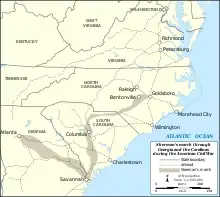



_(a).jpg.webp)
.jpg.webp)